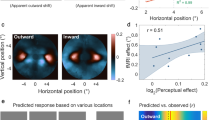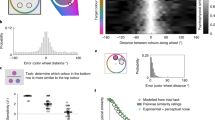Abstract
THE upper member of two horizontal lines, identical in length, drawn within an inverted V-shaped bracket appears to be somewhat longer than the lower. This figure is one example of many two-dimensional spatial patterns known as “the geometrical illusions”. These patterns undergo distortion in such a way as to assume an appearance markedly at variance with their physical form. This particular figure is usually described as the Ponzo illusion, the distortion characterizing it being seen clearly in Fig. 1. The geometrical illusions have provided the topics for a very large number of experimental enquiries. In these, attempts have been made to understand the spatial distortions seen in them, according to features of the structural organization and functional repertoire of the visual projection system. The purpose of the present communication is to initiate consideration of the problem of perceiving visual stimuli seen in the context of illusions, the Ponzo figure being used as a convenient example.
This is a preview of subscription content, access via your institution
Access options
Subscribe to this journal
Receive 51 print issues and online access
$199.00 per year
only $3.90 per issue
Buy this article
- Purchase on Springer Link
- Instant access to full article PDF
Prices may be subject to local taxes which are calculated during checkout
Similar content being viewed by others
Author information
Authors and Affiliations
Rights and permissions
About this article
Cite this article
FISHER, G. Detection of Visual Stimuli located within Angles. Nature 215, 553–554 (1967). https://doi.org/10.1038/215553a0
Received:
Published:
Issue Date:
DOI: https://doi.org/10.1038/215553a0
Comments
By submitting a comment you agree to abide by our Terms and Community Guidelines. If you find something abusive or that does not comply with our terms or guidelines please flag it as inappropriate.



